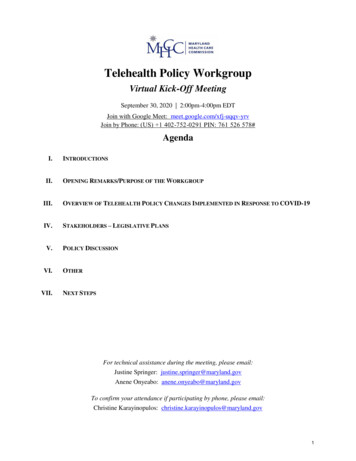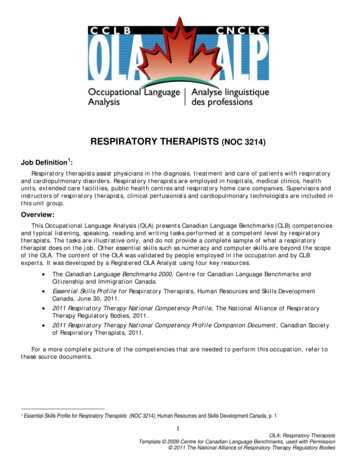
Transcription
7693 Jongs Trau FM v.qxd 12/18/00 7:53 AM Page iPracticePlannersArthur E. Jongsma, Jr., Series EditorHelping therapistshelp their clients . . .Over 250,000 PracticePlanners sold . . .
7693 Jongs Trau FM v.qxd 12/18/00 7:53 AM Page iiPracticePlanners Order FormDocumentation SourcebooksTreatment Planners cover all thenecessary elements for developingformal treatment plans, includingdetailed problem definitions, long-termgoals, short-term objectives, therapeuticinterventions, and DSM-IV diagnoses.Includesdisk!The Complete Adult Psychotherapy Treatment Planner, Second EditionThe Clinical Documentation Sourcebook, Second Edition0-471-31924-4 / 44.95The Child Psychotherapy Treatment Planner, Second Edition0-471-32692-5 / 49.95The Psychotherapy Documentation Primer0-471-34764-7 / 44.95The Adolescent Psychotherapy Treatment Planner, Second Edition0-471-28990-6 / 45.00The Couple and Family Clinical Documentation Sourcebook0-471-34766-3 / 44.95The Chemical Dependence Treatment Planner0-471-25234-4 / 49.95The Clinical Child Documentation Sourcebook0-471-23795-7 / 44.95The Continuum of Care Treatment Planner0-471-19568-5 / 44.950-471-29111-0 / 49.95The Chemical DependenceTreatment Documentation Sourcebook0-471-31285-1 / 49.95The Couples Psychotherapy Treatment Planner0-471-24711-1 / 44.95The Forensic Documentation Sourcebook0-471-25459-2 / 85.00The Employee Assistance (EAP) Treatment Planner0-471-24709-X / 44.95provide a comprehensive collection ofready-to-use blank forms, handouts, andquestionnaires to help you manage yourclient reports and streamline the recordkeeping and treatment process. Featuresclear, concise explanations of the purposeof each form—including when it shouldbe used and at what point. Includes customizable forms on disk.The Continuum of Care Clinical Documentation Sourcebook0-471-34581-4 / 75.00The Pastoral Counseling Treatment Planner0-471-25416-9 / 44.95The Older Adult Psychotherapy Treatment Planner0-471-29574-4 / 44.95NEW AND FORTHCOMINGThe Traumatic Events Treatment PlannerThe Behavioral Medicine Treatment Planner0-471-31923-6 / 44.950-471-39587-0 / 44.95The Special Education Treatment PlannerThe Group Therapy Treatment Planner0-471-37449-0 / 44.95The Family Therapy Treatment Planner0-471-38873-4 / 44.95The Mental Retardation andDevelopmental Disability Treatment Planner0-471-34768-X / 44.95The Severe and Persistent Mental Illness Treatment Planner0-471-38253-1 / 44.95The Social Work and Human Services Treatment Planner0-471-35945-9 / 44.95The Gay and Lesbian Psychotherapy Treatment Planner0-471-37741-4 / 44.95The Rehabilitation Psychology Treatment Planner0-471-35080-X / 44.95Name0-471-35178-4 / 44.95To order, call 1-800-753-0655(Please refer to promo #1-4019 when ordering.)AffiliationAddressOr send this page with payment* to:John Wiley & Sons, Inc., Attn: J. Knott605 Third Avenue, New York, NY 10158-0012City/State/Zip Check enclosedPhone/FaxCard #E-mailw w w. w i l e y. c o m / p ra c t i c e p l a n n e r s Visa MasterCard American ExpressExpiration DateSignature*Please add your local sales tax to all orders.
7693 Jongs Trau FM v.qxd 12/18/00 7:53 AM Page iiiPractice Management Tools for Busy Mental Health ProfessionalsHomework Planners feature dozens of behaviorally based, ready-to-use assignments that are designedfor use between sessions, as well as a disk (Microsoft Word) containing all of the assignments—allowing youto customize them to suit your unique client needs.Brief Therapy Homework Planner0-471-24611-5 / 49.95Brief Couples Therapy Homework Planner0-471-29511-6 / 49.95Brief Adolescent Therapy Homework Planner0-471-34465-6 / 49.95Chemical Dependence TreatmentHomework Planner0-471-32452-3 / 49.95Brief Child Therapy Homework Planner0-471-32366-7 / 49.95Brief Employee Assistance Homework Planner0-471-38088-1 / 49.95Brief Family Therapy Homework PlannerIncludesdisk!0-471-385123-1 / 49.95NEW IN THE PRACTICEPLANNERS SERIES Progress Notes Planners contain complete prewritten progress notes for each presenting problemin the companion Treatment Planners.The Adult Psychotherapy Progress Notes Planner0-471-34763-9 / 44.95The Adolescent Psychotherapy Progress Notes Planner0-471-38104-7 / 44.95The Child Psychotherapy Progress Notes Planner0-471-38102-0 / 44.95To order by phone, call TOLL FREE 1-800-753-0655Or contact us at:John Wiley & Sons, Inc., Attn: J. Knott605 Third Avenue, New York, NY 10158-0012Fax: 1-800-597-3299Online: www.wiley.com/practiceplanners
7693 Jongs Trau FM v.qxd 12/18/00 7:53 AM Page iv TheraScribeSpend MoreTime onPatients—Not PaperworkThe Treatment Planning and Clinical Record Management SystemTheraScribe —the latest version of our popular treatment planning, patient record-keeping software. Facilitates intake/assessment reporting, progress monitoring, and outcomes analysis. Supports grouptreatment and multiprovider treatment teams. Compatible with our full array of PracticePlanners libraries, including our Treatment Planner software versions. This bestselling, easy-to-use Windows -based software allows you to generate fully customizedpsychotherapy treatment plans that meet the requirements of all major accrediting agencies andmost third-party payers. In just minutes, this user-friendly program’son-screen help enables you to createcustomized treatment plans. Praised in the National Psychologist andMedical Software Reviews, this innovative softwaresimplifies and streamlines record-keeping. Available for a single user, or in a networkversion, this comprehensive software packagesuits the needs of all practices—both largeand small.Treatment Planner Upgrade to TheraScribe The behavioral definitions, goals, objectives, and interventions from this Treatment Plannercan be imported into TheraScribe . For purchase and pricing information, please send inthe coupon below or call 1-800-753-0655 or e-mail us at planners@wiley.com.For more information about TheraScribe or the Upgrade to this Treatment Planner, fill in this couponand mail it to: R. Crucitt, John Wiley & Sons, Inc., 7222 Commerce Center Dr., Ste. 240, Colorado Springs,CO 80919 or e-mail us at planners@wiley.com. Please send me information on TheraScribe Please send me information on the Treatment Planner Upgrade to TheraScribe Name of Treatment PlannerPlease send me information on the network version of TheraScribe NameAffiliationAddressCity/State/ZipPhoneE-mailF o r a f r e e d e m o , v i s i t u s o n t h e w e b a t : w w w. w i l e y. c o m / t h e r a s c r i b e
7693 Jongs Trau FM v.qxd 12/18/00 7:53 AM Page vThe Traumatic EventsTreatment Planner
7693 Jongs Trau FM v.qxd 12/18/00 7:53 AM Page viPRACTICE PLANNERS SERIESTreatment PlannersThe Chemical Dependence Treatment PlannerThe Continuum of Care Treatment PlannerThe Couples Psychotherapy Treatment PlannerThe Employee Assistance Treatment PlannerThe Pastoral Counseling Treatment PlannerThe Older Adult Psychotherapy Treatment PlannerThe Complete Adult Psychotherapy Treatment Planner, 2eThe Behavioral Medicine Treatment PlannerThe Group Therapy Treatment PlannerThe Gay and Lesbian Psychotherapy Treatment PlannerThe Child Psychotherapy Treatment Planner, 2eThe Adolescent Psychotherapy Treatment Planner, 2eThe Family Therapy Treatment PlannerThe Severe and Persistent Mental Illness Treatment PlannerThe Mental Retardation and Developmental Disability Treatment PlannerThe Social Work and Human Services Treatment PlannerProgress Notes PlannersThe Adult Psychotherapy Progress Notes PlannerThe Child Psychotherapy Progress Notes PlannerThe Adolescent Psychotherapy Progress Notes PlannerHomework PlannersBrief Therapy Homework PlannerBrief Couples Therapy Homework PlannerChemical Dependence Treatment Homework PlannerBrief Child Therapy Homework PlannerBrief Adolescent Therapy Homework PlannerBrief Employee Assistance Homework PlannerBrief Family Therapy Homework PlannerDocumentation SourcebooksThe Clinical Documentation SourcebookThe Forensic Documentation SourcebookThe Psychotherapy Documentation PrimerThe Chemical Dependence Treatment Documentation SourcebookThe Clinical Child Documentation SourcebookThe Couple and Family Clinical Documentation SourcebookThe Clinical Documentation Sourcebook, 2eThe Continuum of Care Clinical Documentation Sourcebook
7693 Jongs Trau FM v.qxd 12/18/00 7:53 AM Page viiPractice Planners Arthur E. Jongsma, Jr., Series EditorTheTraumatic EventsTreatment PlannerTammi D. KolskiMichael AvrietteArthur E. Jongsma, Jr.JOHN WILEY & SONS, INC.New York Chichester Weinheim Brisbane Singapore Toronto
7693 Jongs Trau FM v.qxd 1/5/01 3:50 PM Page viiiThis book is printed on acid-free paper. 䊊 Copyright 2001 by John Wiley & Sons. All rights reserved.Published simultaneously in Canada.All references to diagnostic codes and the entire content of Appendix B are reprinted with permission from the Diagnostic and Statistical Manual of Mental Disorders, Fourth Edition. Copyright1994. American Psychiatric Association.No part of this publication may be reproduced, stored in a retrieval system or transmitted in anyform or by any means, electronic, mechanical, photocopying, recording, scanning or otherwise, except as permitted under Sections 107 or 108 of the 1976 United States Copyright Act, without either the prior written permission of the Publisher, or authorization through payment of theappropriate per-copy fee to the Copyright Clearance Center, 222 Rosewood Drive, Danvers, MA01923, (978) 750-8400, fax (978) 750-4744. Requests to the Publisher for permission should be addressed to the Permissions Department, John Wiley & Sons, Inc., 605 Third Avenue, New York, NY10158-0012, (212) 850-6011, fax (212) 850-6008, E-Mail: PERMREQ@WILEY.COM.This publication is designed to provide accurate and authoritative information in regard to thesubject matter covered. It is sold with the understanding that the publisher is not engaged in rendering professional services. If legal, accounting, medical, psychological or any other expert assistance is required, the services of a competent professional person should be sought.Designations used by companies to distinguish their products are often claimed as trademarks. Inall instances where John Wiley & Sons, Inc. is aware of a claim, the product names appear in initial capital or all capital letters. Readers, however, should contact the appropriate companies formore complete information regarding trademarks and registration.Note about Photocopy RightsThe publisher grants purchasers permission to reproduce handouts from this book for professional use with their clients.Library of Congress Cataloging-in-Publication Data:Kolski, Tammi.The traumatic events treatment planner / Tammi Kolski, Michael Avriette, Arthur E.Jongsma, Jr.p. cm. — (Practice planners series)ISBN 0-471-39587-0 (paper : alk. paper) — ISBN 0-471-39588-9 (paper/disk : alk. paper)1. Life change events—Handbooks, manuals, etc. 2. Psychic trauma—Handbooks, manuals,etc. 3. Crisis intervention (Mental health services)—Handbooks, manuals, etc. 4. Stress(Psychology)—Handbooks, manuals, etc. 5. Mental health counseling—Handbooks, manuals,etc. I. Avriette, Michael. II. Jongsma, Arthur E., 1943– III. Title. IV. Practice planners.RC455.4.L53 .K65 2001616.85′21—dc2100-043922Printed in the United States of America.10 9 8 7 6 5 4 3 2 1
CONTENTSPractice Planner Series PrefacePrefaceIntroductionAcute Stress DisorderChild Abuse / NeglectCrime Victim TraumaCritical Incidents with Emergency Service Providers(ESPs)DepressionDisasterDomestic ViolenceGeneralized Anxiety DisorderJob LossMedically Caused Death (Adult)Medically Caused Death (Child)Miscarriage / Stillbirth / AbortionPhobiasPosttraumatic Stress Disorder (PTSD)School Trauma (Preelementary)School Trauma (Elementary)School Trauma (Secondary)School Trauma (College)School Trauma (Staff)Sexual Assault / RapeStalking VictimSudden / Accidental Death (Adult)Sudden / Accidental Death (Child)Suicide 5155165175184192199209219ix
xTHE TRAUMATIC EVENTS TREATMENT PLANNERSuicide (Child)Workplace Violence228238Appendix A: Bibliotherapy SuggestionsAppendix B: Index of DSM-IV Codes Associatedwith Presenting ProblemsAbout the Disk245252257
PRACTICE PLANNER SERIES PREFACEThe practice of psychotherapy has a dimension that did not exist 30, 20,or even 15 years ago—accountability. Treatment programs, public agencies, clinics, and even group and solo practitioners must now justify thetreatment of patients to outside review entities that control the paymentof fees. This development has resulted in an explosion of paperwork.Clinicians must now document what has been done in treatment,what is planned for the future, and what the anticipated outcomes ofthe interventions are. The books and software in this Practice Plannerseries are designed to help practitioners fulfill these documentation requirements efficiently and professionally.The Practice Planner series is growing rapidly. It now includes thesecond editions of the Complete Adult Psychotherapy Treatment Planner, the Adolescent Psychotherapy Treatment Planner, and the ChildPsychotherapy Treatment Planner. Additional Treatment Planners aretargeted to specialty areas of practice, including: chemical dependency,the continuum of care, couples therapy, employee assistance, behavioral medicine, therapy with older adults, pastoral counseling, familytherapy, group therapy, neuropsychology, therapy with gays and lesbians, and more.In addition to the Treatment Planners, the series also includesTheraScribe , the latest version of the popular treatment planning, patient record-keeping software, as well as adjunctive books, such as theBrief, Chemical Dependence, Couple, Child, and Adolescent TherapyHomework Planners, The Psychotherapy Documentation Primer, andClinical, Forensic, Child, Couples and Family, Continuum of Care, andChemical Dependence Documentation Sourcebooks—containing formsand resources to aid in mental health practice management. Finally,the most recent additions to the Practical Planner series are the Psychotherapy Progress Notes Planners for adults, adolescents, and children, respectively. These books feature over 1,000 prewritten progressnotes. Components are organized around presenting problems coveredin the specific Treatment Planners written for adults, adolescents, andxi
xiiTHE TRAUMATIC EVENTS TREATMENT PLANNERchildren. The goal of the series is to provide practitioners with the resources they need in order to provide high-quality care in the era of accountability—or, to put it simply, we seek to help you spend more timeon patients, and less time on paperwork.ARTHUR E. JONGSMA, JR.Grand Rapids, Michigan
PREFACEThe Traumatic Events Treatment Planner was developed in response tothe sad state of affairs in today’s society. People have become exposed toviolent crises at an incidence rate that is increasing alarmingly. Individuals in crisis need specialized interventions that are unlike otherforms of therapy. This Treatment Planner provides a framework to offercrisis intervention effectively while incorporating the criteria necessaryfor managed care review and insurance reimbursement. While severalbooks have been written to address individual traumatic events and effective means for successful recovery from such traumas, this Treatment Planner is the first of its kind in that it proposes a menu fortreating many different traumas. While many clinicians specialize inspecific treatment modalities or in treating limited patient populations,we must be prepared to assist any of our patients since traumaticevents can and do occur to anyone. This Planner will assist the mostskilled clinician, as well as the most inexperienced, in delivering effective crisis intervention.Critical incident stress debriefing (CISD) is a fundamental tool of crisis intervention. Critical incident stress debriefing is not a new concept.Its development and implementation began in response to the needs ofpeople affected by war. Though not new, CISD does require specializedtraining. The actual debriefing is a formal, seven-phase process of:1. Establishing ground rules with particular emphasis upon confidentiality2. Expression of the facts of the traumatic event as the individualexperienced them3. Identification and validation of the acute stress reactions experienced4. Identification of any connection between the individual’s personal life history and the trauma5. Exploration of critical incident stress reactions not previouslyidentifiedxiii
xivTHE TRAUMATIC EVENTS TREATMENT PLANNER6. Effective stress management education7. Preparation to return to normal functioningThe International Critical Incident Stress Foundation, under the leadership of Dr. Jeffery Mitchell and Dr. George Everly, has researched andrefined the CISD process and offers training internationally on thetechnique. The American Red Cross, the National Organization of Victim Assistance, and other organizations also provide information onhow to conduct a CISD utilizing the framework as developed by Dr. Jeffery Mitchell. Though it is beyond the scope of this Treatment Plannerto train a clinician in facilitating a CISD, there are several individualsand teams throughout the world who are trained in offering this intervention. These individuals/teams can, and should, be utilized as appropriate for an effective treatment intervention.Our families have offered us much support and patience in the writing of this book. We thank them for that encouragement. This wasTammi’s first experience in writing for this Treatment Planner series.The guidance of Michael and Art, the “experienced authors,” made thecompletion of this book possible. To Russ and Ashleigh Kolski and toDavid and Aline Stebleton, thank you. Michael would like to thankMitchell Willis at the American Red Cross for his support, information,and encouragement. Jen Byrne deserves our appreciation for her patient hours of word processing and assistance in compiling the finalmanuscript, in spite of our computer fumblings. Cristina Wojdylo, thenew editor’s assistant at John Wiley & Sons, has been a very welcomeaddition to the Practice Planner team. She has graciously and efficiently managed a myriad of details relating to the preparation of themanuscript for production. Thanks much, Cristina! Finally, we want tothank Peggy Alexander, our new editor at Wiley, who pushed for thisbook’s completion and is the new energetic force behind the PracticePlanner series.Tammi D. KolskiMichael AvrietteArthur E. Jongsma, Jr.
INTRODUCTIONSince the early 1960s, formalized treatment planning has gradually become a vital aspect of the entire health care delivery system, whether itis treatment related to physical health, mental health, child welfare, orsubstance abuse. What started in the medical sector in the 1960sspread into the mental health sector in the 1970s as clinics, psychiatrichospitals, agencies, and so on, began to seek accreditation from bodiessuch as the Joint Commission on Accreditation of Healthcare Organizations (JCAHO) to qualify for third-party reimbursements. For mosttreatment providers to achieve accreditation, they had to begin developing and strengthening their documentation skills in the area of treatment planning. Previously, most mental health and substance abusetreatment providers had, at best, a “bare-bones” plan that looked similar for most of the individuals they treated. Treatment planning for crisis intervention work was basically unheard of. As a result, clients wereuncertain as to what they were trying to attain in mental health treatment. Goals were vague, objectives were nonexistent, and interventionswere applied equally to all clients regardless of the duration of treatment. Outcome data were not measurable, and neither the treatmentprovider nor the client knew exactly when treatment changed from crisis intervention to ongoing outpatient therapy and when treatment wascomplete. The initial development of rudimentary treatment plans forcrisis intervention and beyond made inroads toward addressing some ofthese issues.With the advent of managed care in the 1980s, treatment planninghas taken on even more importance. Managed care systems recognizecrisis intervention as an integral part of an individual’s recovery fromtrauma. Yet managed care systems insist that clinicians rapidly developa crisis intervention treatment plan. The goal of most managed carecompanies is to expedite the treatment process by prompting the clientand treatment provider to focus on identifying and changing behavioralproblems as quickly as possible. Treatment plans must be specific as tothe problems and interventions, individualized to meet the client’s1
2THE TRAUMATIC EVENTS TREATMENT PLANNERneeds and goals, and measurable in terms of setting milestones thatcan be used to chart the patient’s progress. Pressure from third-partypayers, accrediting agencies, and other outside parties has therefore increased the need for clinicians to produce effective, high-quality treatment plans in a short time frame. However, many mental healthproviders have little experience in treatment plan development. Ourpurpose in writing this book is to clarify, simplify, and accelerate thetreatment planning process, starting with crisis intervention.TREATMENT PLAN UTILITYDetailed written treatment plans can benefit not only the client, therapist, treatment team, insurance community, and treatment agency, butalso the overall psychotherapy profession. The client is served by a written plan because it stipulates the issues that are the focus of the treatment process. It is very easy for both provider and client to lose sight ofwhat the traumatic issues were that brought the patient into therapyas outpatient counseling services continue. The treatment plan is aguide that structures the focus of the therapeutic contract. Since issuescan change as therapy progresses, the treatment plan must be viewedas a dynamic document that can and must be updated to reflect anymajor change of problem, definition, goal, objective, or intervention.Clients and therapists benefit from the treatment plan, which forcesboth to think about therapy outcomes. Behaviorally stated, measurableobjectives clearly focus the treatment endeavor. Clients no longer haveto wonder what therapy is trying to accomplish from the crisis intervention forward. Clear objectives also allow the patient to channel effort into specific changes that will lead to the long-term goal of problemresolution. Crisis intervention is no longer a vague contract to just talkhonestly and openly about emotions and cognitions until the client feelsbetter. Both client and therapist are concentrating on specifically statedobjectives using specific interventions.Providers are aided by treatment plans because they are forced tothink analytically and critically about therapeutic interventions thatare best suited for objective attainment for the patient. Therapists weretraditionally trained to “follow the patient,” but now a formalized planis the guide to the treatment process. The therapist must give advanceattention to the technique, approach, assignment, or cathartic targetthat will form the basis for interventions.Clinicians benefit from clear documentation of treatment because itprovides a measure of added protection from possible patient litigation.Malpractice suits are increasing in frequency and insurance premiumsare soaring. The first line of defense against allegations is a complete
INTRODUCTION3clinical record detailing the treatment process. A written, individualized, formal treatment plan that is the guideline for the crisis evaluation and following therapeutic process, that has been reviewed andsigned by the client, and that is coupled with problem-oriented progressnotes is a powerful defense against exaggerated or false claims.A well-crafted treatment plan that clearly stipulates presentingproblems and intervention strategies facilitates the crisis interventionand following treatment process carried out by team members in inpatient, residential, or intensive outpatient settings. Good communicationbetween team members about what approach is being implemented andwho is responsible for which intervention is critical. Team meetingswhich were held to discuss patients in crisis used to be the only sourceof interaction between providers; often, therapeutic conclusions or assignments were not recorded. Now, a thorough treatment plan stipulates in writing the details of objectives and the varied interventions(pharmacologic, milieu, group therapy, didactic, recreational, individual therapy, etc.) and who will implement them.Every treatment agency or institution is constantly looking for waysto increase the quality and uniformity of the documentation in the clinical record. A standardized, written treatment plan with problem definitions, goals, objectives, and interventions in every client’s fileenhances that uniformity of documentation. This uniformity eases thetask of record reviewers inside and outside the agency. Outside reviewers, such as JCAHO, insist on documentation that clearly outlines a crisis intervention treatment plan, progress, and discharge status.The demand for accountability from third-party payers and healthmaintenance organizations (HMOs) is partially satisfied by a writtentreatment plan and complete progress notes. More and more managedcare systems are demanding a structured therapeutic contract that hasmeasurable objectives and explicit interventions, even for crisis intervention. Clinicians cannot avoid this move toward being accountable tothose outside the treatment process.The psychotherapy profession stands to benefit from the use of moreprecise, measurable objectives to evaluate success in crisis interventionand ongoing mental health treatment. With the advent of detailedtreatment plans, outcome data can be more easily collected for interventions that are effective in achieving specific goals.HOW TO DEVELOP A TREATMENT PLANThe process of developing a treatment plan involves a logical series ofsteps that build on each other much like constructing a house. The foundation of any effective treatment plan is the data gathered in a thorough
4THE TRAUMATIC EVENTS TREATMENT PLANNERbiopsychosocial assessment. As the client has survived a traumaticevent, the clinician must sensitively listen to and understand what theclient struggles with in terms of emotional status, social network, physical health, coping skills, interpersonal conflicts, self-esteem, family oforigin issues, and so on. Assessment data may be gathered from a socialhistory, physical exam, clinical interview, psychological testing, or contact with a client’s significant others. The integration of the data by theclinician or the multidisciplinary treatment team members is critical forunderstanding the client, as is an awareness of the basis of the client’sstruggle. We have identified six specific steps for developing an effectivetreatment plan based on the assessment data.Step One: Problem SelectionAlthough the client is presenting as a result of surviving an identifiedcrisis, the clinician must determine if there are other issues complicating the client’s presentation. Usually, the primary problem will be therecent trauma the client experienced, and secondary problems are issues that were likely present prior to the crisis occurring. Some otherproblems may have to be set aside as not urgent enough to requiretreatment at this time. An effective treatment plan can only deal with afew selected problems or treatment will lose its direction. This Planneroffers 26 crisis situations or expected problems as a result of the traumafrom which to select those that most accurately represent your client’spresenting issues.As the client progresses from crisis intervention to an ongoing outpatient therapy relationship, it is important to include opinions fromthe client as to his or her prioritization of issues for which help is beingsought. A client’s motivation to participate in and cooperate with thetreatment process depends, to some extent, on the degree to whichtreatment addresses his or her greatest needs.Step Two: Problem DefinitionEach individual client presents with unique nuances as to how crisis reactions are revealed in his or her life. Therefore, each problem that isselected for treatment focus requires a specific definition about how it isevidenced in the particular client. The symptom pattern should be associated with diagnostic criteria and codes such as those found in theDiagnostic and Statistical Manual or the International Classification ofDiseases. The Planner, following the pattern established by DSM-IV, offers such behaviorally specific definition statements to choose from or
INTRODUCTION5to serve as a model for your own personally crafted statements. You willfind several behavior symptoms or syndromes listed that may characterize one of the 26 presenting problems.Step Three: Goal DevelopmentThe next step in treatment plan development is that of setting broadgoals for the resolution of the target problem. These statements neednot be crafted in measurable terms but can be global, long-term goalsthat indicate a desired positive outcome to the treatment procedures.The Planner suggests several possible goal statements for each problem, but one statement is all that is required in a treatment plan.Step Four: Objective ConstructionIn contrast to long-term goals, objectives must be stated in behaviorallymeasurable language. It must be clear when the client has achieved theestablished objectives; therefore, vague, subjective objectives are notacceptable. Review agencies (e.g., JCAHO), HMOs, and managed careorganizations insist that psychological treatment outcomes be measurable. The objectives presented in this Planner are designed to meet thisdemand for accountab
The Adult Psychotherapy Progress Notes Planner -471-34763-9 / 44.95 The Adolescent Psychotherapy Progress Notes Planner -471-38104-7 / 44.95 The Child Psychotherapy Progress Notes Planner -471-38102- / 44.95 Includes disk! 7693_Jongs_Trau_FM_v.qxd 12/18/00 7:53AM Pageiii











